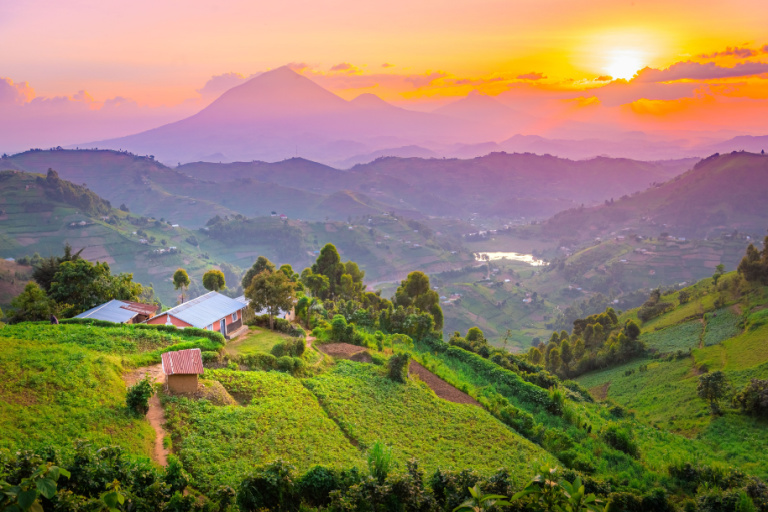
Gunter Nuyts/Shutterstock
When Is the Best Time to Visit Uganda?
he best time to visit Uganda is during the dry seasons, which run from June to September and December to February.
During these months, the weather is generally mild and sunny, with little to no rain. This makes it ideal for wildlife viewing and outdoor activities such as hiking, gorilla trekking, and chimpanzee tracking.
Benefits of visiting Uganda during the dry seasons
- Mild weather: Uganda has a tropical climate, but the dry seasons offer mild and pleasant temperatures, making it ideal for sightseeing, exploring, and enjoying the outdoors.
- Clear skies: The dry seasons are characterized by clear skies and sunny days, which is ideal for wildlife viewing, as animals are more active and easier to spot in the open.
- Accessible roads and trails: During the dry seasons, roads and trails are generally in good condition, making it easy to get around and explore the country.
How to enjoy Uganda during the dry seasons
- June to September: This is the peak season for gorilla trekking in Bwindi Impenetrable National Park and Mgahinga Gorilla National Park. It is also a good time to visit other national parks such as Queen Elizabeth National Park, Murchison Falls National Park, and Kidepo Valley National Park for wildlife viewing.
- December to February: This is another great time for wildlife viewing in Uganda, as animals congregate around water sources during the dry season. It is also a good time to visit the northern region of Uganda for camel safaris and cultural experiences.
Why visit Uganda during the shoulder seasons?
The shoulder seasons (May-June and October-November) offer a number of benefits for travelers, including:
- Fewer crowds: The shoulder seasons are less crowded than the peak summer season, so you’ll be able to enjoy Uganda’s popular tourist attractions without having to deal with large crowds.
- Lower prices: Prices for flights, accommodation, and activities are generally lower during the shoulder seasons than during the peak summer season. This means you can save money on your trip without having to sacrifice quality.
We recommend visiting Uganda during the dry seasons (June to September and December to February) to enjoy the best possible weather and wildlife viewing experience. However, if you’re looking to save money and avoid the crowds, the shoulder seasons are also a great time to visit.
 Average Temperatures by Month
Average Temperatures by Month
|
Jan |
Feb |
Mar |
Apr |
May |
Jun |
Jul |
Aug |
Sep |
Oct |
Nov |
Dec |
| Fahrenheit |
79°
|
79°
|
79°
|
79°
|
78°
|
77°
|
77°
|
78°
|
78°
|
78°
|
78°
|
78°
|
| Celsius |
26°
|
26°
|
26°
|
26°
|
26°
|
25°
|
25°
|
26°
|
26°
|
26°
|
26°
|
26°
|
Climate in Uganda
Summer Season in Uganda
The dry season in Uganda, often considered as a 'summer' period, is characterized by less rainfall and generally drier conditions. This is an ideal time for wildlife viewing, as animals tend to gather around water sources, and the reduced foliage improves visibility. The weather is predominantly sunny, making it a popular time for tourists.
Rainy Season in Uganda
Uganda experiences two rainy seasons, with the first from March to May and the second from September to November. These periods are marked by frequent and sometimes heavy rainfall. The rains bring lush greenery to the landscape and are crucial for the country's agriculture. However, the heavy rains can make some roads impassable and might hinder certain outdoor activities.
Winter Season in Uganda
Uganda does not experience a winter season in the traditional sense of cold temperatures and snow. The closest equivalent would be the rainy seasons, particularly from March to May, when the temperatures are slightly cooler than during the dry seasons, but still generally warm. The term 'winter' is not commonly used in the Ugandan context to describe any specific season.
Our Recommendations
| Destination |
Jan |
Feb |
Mar |
Apr |
May |
Jun |
Jul |
Aug |
Sep |
Oct |
Nov |
Dec |
| Uganda |
 |
 |
 |
 |
 |
 |
 |
 |
 |
 |
 |
 |






